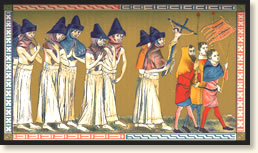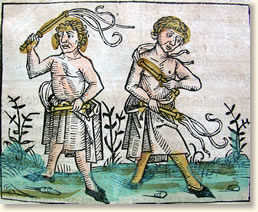|
The Flagellants Attempt to Repel
the Black Death, 1349
 |
A Procession of Flagellants
in the Netherlands, ca, 1350 |
The Flagellants were religious zealots of the Middle Ages in Europe who demonstrated their religious fervor and sought atonement for their sins by vigorously whipping themselves in public displays of penance. This approach to achieving redemption was most popular during times of crisis. Prolonged plague, hunger, drought and other natural maladies would motivate thousands to resort to this extreme method of seeking relief. Despite condemnation by the Catholic Church, the movement gained strength and reached its greatest popularity during the onslaught of the Black Death that ravaged Europe in the mid-fourteenth century. Wearing white robes, large groups of the sect (many numbering in the thousands) roamed the countryside dragging crosses while whipping themselves into a religious frenzy.
Although prevalent on the European continent, the Flagellants did not achieve popularity in England. However, a large contingent of the sect crossed the English Channel in 1349 and converged on London. The following description of the Flagellants comes to us from Sir Robert of Avesbury who witnessed their ritual:
"In that same year of 1349, about Michaelmas (September, 29) over six hundred men came to London from Flanders, mostly of Zeeland and Holland origin. Sometimes at St Paul's and sometimes at other points in the city they made two daily public appearances wearing cloths from the thighs to the ankles, but otherwise stripped bare. Each wore a cap marked with a red cross in front and behind.
 |
A Contemporary View
of the Flagellants, ca 1350 |
Each had in his right hand a scourge with three tails. Each tail had a knot and through the middle of it there were sometimes sharp nails fixed. They marched naked in a file one behind the other and whipped themselves with these scourges on their naked and bleeding bodies.
Four of them would chant in their native tongue and, another four would chant in response like a litany. Thrice they would all cast themselves on the ground in this sort of procession, stretching out their hands like the arms of a cross. The singing would go on and, the one who was in the rear of those thus prostrate acting first, each of them in turn would step over the others and give one stroke with his scourge to the man lying under him.
This went on from the first to the last until each of them had observed the ritual to the full tale of those on the ground. Then each put on his customary garments and always wearing their caps and carrying their whips in their hands they retired to their lodgings. It is said that every night they performed the same penance."
References:
This eyewitness account appears in: Robert of Avesbury: E.M. Thompson (ed), Robertus de Avesbury de Gestis Mirabilbus Regis Edwardi Tertii, Roll Series 1889; Cohn, Norman, The Pursuit of the Millennium: Revolutionary Millenarians and Mystical Anarchists of the Middle Ages (1970).
How To Cite This Article:
"The Flagellants Attempt to Repel the Black Death, 1349", EyeWitness to History, www.eyewitnesstohistory.com
(2010).
|






